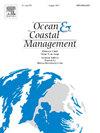Assessing the spatial pattern of capacity and demand for coastal protection ecosystem services in mainland China
IF 4.8
2区 环境科学与生态学
Q1 OCEANOGRAPHY
引用次数: 0
Abstract
Coastlines are increasingly threatened by natural hazards such as intensifying storms, flooding, and erosion. The safety of lives and property in coastal zones can only be ensured when the biophysical capacity for coastal protection services adequately meets demand. Yet existing capacity-demand models often fail to account for the combined impacts of marine and terrestrial hazards (e.g. extreme rainfall coinciding with storm surges) and the mitigating effects of human critical infrastructure (e.g. dikes). To address this gap, we analyzed 228 county-level coastal assessment units along the Chinese mainland. First, we measured the biophysical capacity of coastal protection services using five indicators related to natural ecosystem properties. Next, we evaluated demand for coastal protection services by integrating six natural hazard indicators, four human exposure indicators, and four social adaptive capacity indicators into a risk reduction model. Finally, we identified nine distinct types of capacity-demand relationships across space (High-Low, High-Medium, High-High, Medium-Low, Medium-Medium, Medium-High, Low-Low, Low-Medium, and Low-High). Seventy-seven counties exhibited relatively low capacity and relatively high demand, located mostly in Guangdong and Jiangsu provinces. Furthermore, we found that many economically underdeveloped counties showed capacity-demand mismatches (e.g. the coastal counties of Hainan Province), perhaps because local infrastructure development has not kept pace with overall economic growth. This study provides a comprehensive framework for identifying spatial patterns of coastal protection services capacity-demand mismatches, thereby informing decision-making to enhance disaster resilience in China's coastal zones.
中国大陆海岸保护生态系统服务能力与需求空间格局评估
海岸线正日益受到自然灾害的威胁,如日益加剧的风暴、洪水和侵蚀。只有当海岸保护服务的生物物理能力充分满足需求时,才能确保沿海地区的生命和财产安全。然而,现有的能力需求模型往往未能考虑到海洋和陆地灾害(例如与风暴潮同时发生的极端降雨)和人类关键基础设施(例如堤坝)的缓解作用的综合影响。为了解决这一差距,我们分析了中国大陆228个县级沿海评估单位。首先,我们使用与自然生态系统属性相关的五个指标来衡量海岸保护服务的生物物理能力。接下来,我们通过将6个自然灾害指标、4个人类暴露指标和4个社会适应能力指标整合到风险降低模型中来评估海岸保护服务的需求。最后,我们确定了跨空间的九种不同类型的产能需求关系(高-低、高-中、高-高、中低、中-中、中高、低-低、低-中和低-高)。77个县产能相对较低,需求相对较高,主要分布在广东和江苏两省。此外,我们发现许多经济欠发达的县(如海南省的沿海县)出现了产能需求不匹配,这可能是因为当地基础设施的发展没有跟上整体经济增长的步伐。本研究为识别海岸带防护服务能力需求错配的空间格局提供了一个综合框架,从而为中国海岸带防护服务能力需求错配的决策提供信息。
本文章由计算机程序翻译,如有差异,请以英文原文为准。
求助全文
约1分钟内获得全文
求助全文
来源期刊

Ocean & Coastal Management
环境科学-海洋学
CiteScore
8.50
自引率
15.20%
发文量
321
审稿时长
60 days
期刊介绍:
Ocean & Coastal Management is the leading international journal dedicated to the study of all aspects of ocean and coastal management from the global to local levels.
We publish rigorously peer-reviewed manuscripts from all disciplines, and inter-/trans-disciplinary and co-designed research, but all submissions must make clear the relevance to management and/or governance issues relevant to the sustainable development and conservation of oceans and coasts.
Comparative studies (from sub-national to trans-national cases, and other management / policy arenas) are encouraged, as are studies that critically assess current management practices and governance approaches. Submissions involving robust analysis, development of theory, and improvement of management practice are especially welcome.
 求助内容:
求助内容: 应助结果提醒方式:
应助结果提醒方式:


